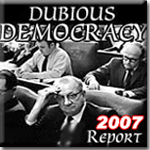Dubious Democracy 2005
 Welcome to FairVote’s 2005 release of Dubious Democracy, our biannual
report on the state of democracy in elections to the U.S. House of
Representatives. This is the sixth edition of Dubious Democracy, which
first came out in 1995 with an analysis of election data from 1982 through
1994. We now have added election data through 2004.
Welcome to FairVote’s 2005 release of Dubious Democracy, our biannual
report on the state of democracy in elections to the U.S. House of
Representatives. This is the sixth edition of Dubious Democracy, which
first came out in 1995 with an analysis of election data from 1982 through
1994. We now have added election data through 2004.Dubious Democracy has one overriding message: although our constitutional framers gave the House of Representatives extraordinary powers and, of all the branches of government, the clearest accountability to the American people, that accountability has been destroyed beyond all recognition.
This breakdown of democratic accountability can be measured in different ways. Here are two:
- Accountability of leadership: Since 1952, more than
half a century ago, the White House has changed partisan control six
times in 13 elections (after elections in 1960, 1968, 1976, 1980, 1992
and 2000), and control of the U.S. Senate has changed several times,
including 5 times in the past 25 years. Meanwhile, “the people’s house”
has changed control just once in 26 elections.
- Voter choice: The past two House elections
were the least competitive in American history by most standards. In
each of the four national elections since 1996, more than 98% of
incumbents have won, and more than 90% of all races have been won by
non-competitive margins of more than 10%.
Dubious Democracy 2005 provides a comprehensive assessment of the level of competition and accuracy of representation in U.S. House elections in all 50 states from 1982 to 2004. It ranks each state on a “democracy index” based on average margin of victory, percentage of seats to votes, how many voters elect candidates and number of House races won by overwhelming landslides. Some highlighted national facts include:
- Sky-high incumbency rates. Only five incumbents
lost to challengers in 2004 -- the second lowest in our nation’s
history. Nearly nine in ten incumbents were re-elected by “landslide”
margins of at least 20 percent.
- Landslides. In 14 states, every race was won by a
landslide margin of at least 20 percent in 2004. Only four states (all
with less than three seats) recorded no landslide wins.
- High victory margins. The average victory margin
was a whopping 40 percent. Seven of every eight (83%) U.S. House races
were won by landslide margins of at least 20 percent in 2004. Only 23
races (5%) were won by competitive margins of less than 10 percent.
- Apathy. Nearly one out of every 11 voters skipped
over their House race on the ballot. Despite a surge in turnout due to
the presidential race, more than 62 percent of eligible voters – nearly
two in three – did not vote for a winning House representative.
- Florida: Incumbents won 139 of 140 House races in
Florida in 1992-2004. Of 25 House races in 2004, 24 (96%) were won by
landslides.
- Massachusetts: Of the state’s 30 House races in
2000-2004, 16 were completely uncontested. Six more were won by at
least 40%, and the remaining 8 won by at least 20% landslides. The
state’s 65% overall margin of victory in House races was the nation’s
largest; seven incumbents won their last four races by landslides.
- Arizona: Voters adopted a redistricting reform
proposal in 2000 that established a commission to draw district lines,
yet competition actually decreased in the state elections in 2002-2004.
Fifteen of 16 U.S. House races in these two elections were won by
landslide margins of at least 20%, including four races by more than
40%.
- California: 51 of the 53 House races held in 2004
were won by landslide margins that exceeded 20%. Of the 101 incumbents
who ran for reelection in 2002 and 2004, all were reelected, and 99 of
these 101 incumbents won by landslides.
Recent years have exaggerated the problem of lack of competition for several reasons: (1) incumbents and parties are more sophisticated about what incumbent officeholders should do in serving their district to shield themselves from competition; (2) new computerized methods of redistricting, combined with the need to draw new districts every ten years and the lack of nonpartisan standards governing the process, lead to even more districts with a partisan tilt; (3) those partisan tilts are more decisive than ever because the national parties have become quite distinct in most voters’ minds, leading to less ticket-splitting.
The end result is that most voters don’t have a choice between two candidates, let alone three-- so much for a healthy two-party system, where issues ignored by one major party can be meaningfully addressed by the other one. If voters would like to hear about the policy ideas of independent and third party candidates, they’re even more shut out. Yes, voter turnout is down over recent decades, but it’s time to stop blaming the victims of the American electoral system – the voters – and start addressing the root causes of alienation and lack of representation: our winner-take-all electoral system, buttressed by incumbent privileges, campaign cash and partisan redistricting run amok.
FairVote – The Center for Voting and Democracy advocates for changes that promote voter choice and fair representation, such as: proportional voting methods, instant runoff voting and public interest redistricting methods. These reforms can greatly improve representation and accountability, increase competition, enhance debate of issues and ultimately improve public policy and national unity.Dubious Democracy makes it clear that serious consideration of these changes is long overdue.